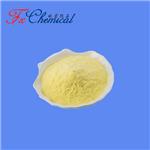Zinc Acetate: Pharmacological Characteristics and Clinical Efficacy
General Description
Zinc acetate is a soluble compound that effectively modulates copper absorption in the gastrointestinal tract, primarily by inducing metallothionein production, which binds copper and prevents its entry into the bloodstream. This pharmacological mechanism allows zinc acetate to maintain copper levels below toxic thresholds in patients with Wilson's disease, demonstrating significant efficacy in both maintenance therapy and pre-symptomatic treatment. Additionally, zinc acetate is safe for pregnant patients, offering a non-teratogenic option for managing Wilson's disease during pregnancy. Overall, zinc acetate plays a crucial role in the long-term management of copper metabolism disorders, ensuring effective control of copper levels.

Figure 1. Zinc acetate
Pharmacological Characteristics
Chemistry and Mechanism of Action
Zinc acetate is a soluble compound that plays a critical role in modulating copper absorption in the gastrointestinal tract. When zinc acetate is administered, it dissolves in the stomach, releasing ionic zinc, which then travels to the small intestine. Within the intestinal cells, zinc acetate influences the production of metallothionein, a protein that has a high affinity for copper. At sufficiently elevated zinc concentrations, zinc acetate stimulates the induction of metallothionein, which subsequently binds to copper entering the cell from the intestinal lumen. This crucial interaction effectively prevents the copper from being transferred into the bloodstream and thereby inhibits its absorption. As intestinal cells have a lifespan of approximately six days, they eventually die and slough off into the bowel lumen, carrying along the excess copper complexed with metallothionein, which is ultimately lost in the stool. Therefore, the primary pharmacological mechanism of zinc acetate lies in its ability to block copper absorption through the induction of metallothionein. 1
Pharmacological Aspects
The effectiveness of zinc acetate in blocking intestinal absorption of copper hinges on multiple factors. One important consideration is the timing of zinc acetate administration relative to food and beverage intake, as it is advisable to separate administration from meals by at least one hour. Components found in food, including phytates and dietary fiber, can bind with zinc acetate and inhibit its absorption in the intestinal cells. The dosage of zinc acetate also plays a significant role; the standard dietary zinc intake is around 10 to 15 milligrams, but to effectively curb copper absorption, a daily intake of at least 75 milligrams of zinc is required. Therefore, the typical recommended adult dosage of zinc acetate is 50 milligrams, taken three times a day, ensuring sufficient zinc levels for blocking copper absorption while providing a safety buffer for adherence issues. 1
Cumulative Effect and Interaction with Other Anticopper Agents
The induction effect of zinc acetate on metallothionein is cumulative, requiring approximately two weeks of continuous therapy to achieve maximal blockade of copper absorption as evidenced by reduced levels of 64Cu absorption. Upon cessation of zinc acetate therapy, the de-induction process is gradual and has a half-life of about ten days, indicating that temporary lapses in treatment do not significantly compromise the therapeutic effects. Despite this effectiveness, dietary restrictions on copper intake become less critical for patients on zinc acetate, although limiting high-copper foods such as liver and shellfish is still recommended. Concurrent administration of zinc acetate with other anticopper agents, such as D-penicillamine and trientine, can be beneficial during the initial treatment phase when there is excess copper present. However, during long-term maintenance therapy, combining multiple anticopper agents offers no additional advantages, as the interactions can diminish the effectiveness of both zinc acetate and the other agents involved, leading to a negative copper balance similar to that achieved with zinc acetate alone. 1
Clinical Efficacy
Maintenance Therapy
Zinc acetate has demonstrated considerable efficacy as a maintenance therapy for managing copper levels in patients with Wilson's disease. Following an initial treatment phase of two to four months, zinc acetate helps maintain copper levels below toxic thresholds. By continuously depleting the body's excess copper, zinc acetate prevents the reaccumulation of copper and thus reduces the risk of further toxicity. Although zinc acetate does not directly ameliorate the underlying pathology or improve symptoms, its effectiveness is evident through a negative copper balance and a significant reduction in urinary copper excretion over time. This indicates a successful management of copper loading, highlighting the role of zinc acetate in maintaining the stability of copper levels in the body. 2
Pre-symptomatic and Pregnant Patients
Zinc acetate is also effective for treating pre-symptomatic patients who are at high risk of developing symptoms of Wilson's disease. Prophylactic treatment with zinc acetate has been shown to effectively prevent the onset of symptoms by improving urinary copper levels and reducing non-ceruloplasmin copper in the plasma. Additionally, zinc acetate is a suitable option for pregnant patients, as it is non-teratogenic and helps control Wilson's disease during pregnancy without posing significant risks to the fetus. Compared to traditional therapies, zinc acetate provides a safer alternative, particularly for pregnant women who must continue anticopper therapy during this vulnerable time. Overall, the use of zinc acetate has garnered a consensus of efficacy across various studies, reinforcing its role in long-term management of copper metabolism disorders. 2
References:
[1] L A ANDERSON S K B S L Hakojarvi. Zinc acetate treatment in Wilson’s disease.[J]. Annals of Pharmacotherapy, 1998, 32 1. DOI:10.1345/aph.17075.Lastest Price from Zinc acetate manufacturers

US $1200.00-1100.00/ton2025-08-11
- CAS:
- 557-34-6
- Min. Order:
- 1ton
- Purity:
- 99%
- Supply Ability:
- 1000T/M

US $0.00/KG2025-04-21
- CAS:
- 557-34-6
- Min. Order:
- 1KG
- Purity:
- 98%min
- Supply Ability:
- 30tons/month


